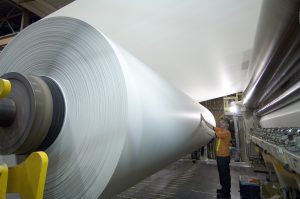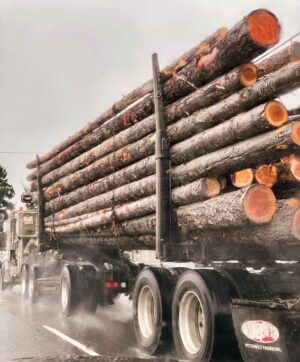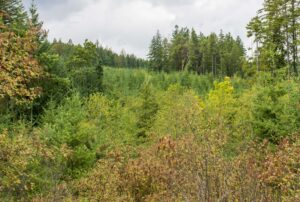 International Pulp Week 2025 opened in Vancouver with a note of celebration and reflection as delegates marked the event’s 20th anniversary. “After decades of being in Montreal in January… we decided to move the event to Vancouver and into the spring and summer months,” said Tim Brown, Vice-President at Numera Analytics.
International Pulp Week 2025 opened in Vancouver with a note of celebration and reflection as delegates marked the event’s 20th anniversary. “After decades of being in Montreal in January… we decided to move the event to Vancouver and into the spring and summer months,” said Tim Brown, Vice-President at Numera Analytics.  Over the years, Brown noted, the event has drawn participants from more than 50 countries and consistently focused on the industry’s most pressing challenges and opportunities. “It’s an industry that has innovated, adapted, and is one that itself is smarter and more sustainable.” Following Brown’s welcome, he introduced Kevin Mason, Managing Director of ERA Forest Products Research, who returned to the IPW stage to reflect on two decades of transformation in the global pulp sector—and to look ahead.
Over the years, Brown noted, the event has drawn participants from more than 50 countries and consistently focused on the industry’s most pressing challenges and opportunities. “It’s an industry that has innovated, adapted, and is one that itself is smarter and more sustainable.” Following Brown’s welcome, he introduced Kevin Mason, Managing Director of ERA Forest Products Research, who returned to the IPW stage to reflect on two decades of transformation in the global pulp sector—and to look ahead.
…Mason highlighting four key developments that have defined the past two decades: “A dramatic rise in demand for market pulp from China… Chinese demand met by massive growth in hardwood capacity in Latin America… hardwood steadily gained share versus softwood… and tissue expanded while printing and writing papers contracted.”  Looking ahead, Mason projected the estimated end-use composition of pulp demand in 2040: tissue at 54%, specialty papers at 24%, packaging at 12%, fluff-based products at 7%, and graphic paper at 3%. He also shared a slide titled “Potential Developments Over the Next 20 Years,” listing several scenarios: continued expansion of domestic pulp capacity in China; hardwood gaining further share over softwood (though possibly nearing saturation); and the potential for dramatic growth in specialty papers and packaging—if government policy supports a shift away from plastics.
Looking ahead, Mason projected the estimated end-use composition of pulp demand in 2040: tissue at 54%, specialty papers at 24%, packaging at 12%, fluff-based products at 7%, and graphic paper at 3%. He also shared a slide titled “Potential Developments Over the Next 20 Years,” listing several scenarios: continued expansion of domestic pulp capacity in China; hardwood gaining further share over softwood (though possibly nearing saturation); and the potential for dramatic growth in specialty papers and packaging—if government policy supports a shift away from plastics.

 VANCOUVER, BC —
VANCOUVER, BC —  While the pulp and paper industry is inherently local—particularly in terms of production and sourcing of raw materials—trade is fundamentally cross-border and international. As a result, the sector is highly exposed to trade barriers and tensions, such as those created by the tariff policies introduced during the Trump administration. Tariffs are expected to put significant pressure on transportation and logistics—sectors that are intrinsically linked to the pulp and paper industry. This strain is partly mitigated by the fact that many pulp and paper companies have made substantial investments in overseas production capacity. Recent mergers in the industry, such as the Smurfit Kappa–WestRock merger and the International Paper–DS Smith merger, are also likely to offset some of the negative impacts of tariffs. These newly formed giants now operate production facilities in both Europe and the US. …This consolidation trend may render the pulp and paper industry more resilient.
While the pulp and paper industry is inherently local—particularly in terms of production and sourcing of raw materials—trade is fundamentally cross-border and international. As a result, the sector is highly exposed to trade barriers and tensions, such as those created by the tariff policies introduced during the Trump administration. Tariffs are expected to put significant pressure on transportation and logistics—sectors that are intrinsically linked to the pulp and paper industry. This strain is partly mitigated by the fact that many pulp and paper companies have made substantial investments in overseas production capacity. Recent mergers in the industry, such as the Smurfit Kappa–WestRock merger and the International Paper–DS Smith merger, are also likely to offset some of the negative impacts of tariffs. These newly formed giants now operate production facilities in both Europe and the US. …This consolidation trend may render the pulp and paper industry more resilient. 

 Duties placed on Canadian lumber entering the U.S. could eventually help markets here, a local mill manager is saying, but they are still a few months out. There’s a misconception that recent tariffs announced against Canadian goods extended to lumber products, F.H. Stoltze Land and Lumber vice president and general manager Paul McKenzie said Monday. The U.S.-Canada lumber market is governed under a separate and oft disputed softwood agreement that places duties on Canadian lumber. The duties are supposed to keep Canadians from dumping government subsidized lumbers onto U.S. markets. They currently amount to about 14% combined. By August or September, they’re expected to climb to 34%, McKenzie noted. That will be helpful to us,” McKenzie said. Stoltze has operated its independent mill in Columbia Falls, Montana over 100 years. McKenzie said Canadians are currently dumping their products into the U.S. ahead of the hike in duties.
Duties placed on Canadian lumber entering the U.S. could eventually help markets here, a local mill manager is saying, but they are still a few months out. There’s a misconception that recent tariffs announced against Canadian goods extended to lumber products, F.H. Stoltze Land and Lumber vice president and general manager Paul McKenzie said Monday. The U.S.-Canada lumber market is governed under a separate and oft disputed softwood agreement that places duties on Canadian lumber. The duties are supposed to keep Canadians from dumping government subsidized lumbers onto U.S. markets. They currently amount to about 14% combined. By August or September, they’re expected to climb to 34%, McKenzie noted. That will be helpful to us,” McKenzie said. Stoltze has operated its independent mill in Columbia Falls, Montana over 100 years. McKenzie said Canadians are currently dumping their products into the U.S. ahead of the hike in duties. 

 Uncertainty regarding tariffs continues to challenge companies across industries. It’s a common theme in every conversation I’ve had with fellow business owners lately: How do we plan, price or grow when the rules are constantly shifting? In our case, the lumber industry got a temporary break—framing lumber from Canada, which makes up over 30% of the US market, was exempt from the original tariffs. That’s good news for now, especially for residential construction. But there’s still no clarity on imports from other key countries like Brazil and China, where tariffs remain in full effect. That could have a serious impact on specialty products like Ipe and hardwood veneers. Other building materials—fasteners, finishes, flooring, and more—are also caught in the middle. …That cost will be passed on to the end user. Businesses like ours don’t have the luxury of absorbing increased costs indefinitely. If we did, we’d be out of business.
Uncertainty regarding tariffs continues to challenge companies across industries. It’s a common theme in every conversation I’ve had with fellow business owners lately: How do we plan, price or grow when the rules are constantly shifting? In our case, the lumber industry got a temporary break—framing lumber from Canada, which makes up over 30% of the US market, was exempt from the original tariffs. That’s good news for now, especially for residential construction. But there’s still no clarity on imports from other key countries like Brazil and China, where tariffs remain in full effect. That could have a serious impact on specialty products like Ipe and hardwood veneers. Other building materials—fasteners, finishes, flooring, and more—are also caught in the middle. …That cost will be passed on to the end user. Businesses like ours don’t have the luxury of absorbing increased costs indefinitely. If we did, we’d be out of business. There has been a lot of news recently on higher tariffs between the U.S. and its trading partners, including Canada and Mexico. One concern that is top of mind for many LBM dealers is how these new tariffs will affect lumber and other materials sold at yards and stores across the country. How concerned should I be and what action, if any, can I take to protect my business? Responses from lumberyards, full-line building material dealers, and specialty dealers/distributors:
There has been a lot of news recently on higher tariffs between the U.S. and its trading partners, including Canada and Mexico. One concern that is top of mind for many LBM dealers is how these new tariffs will affect lumber and other materials sold at yards and stores across the country. How concerned should I be and what action, if any, can I take to protect my business? Responses from lumberyards, full-line building material dealers, and specialty dealers/distributors: Economic growth forecasts for the US and globally were cut further by the Organisation for Economic Co-operation and Development (OEDC) as President Trump’s tariff turmoil weighs on expectations. The US growth outlook was downwardly revised to just 1.6% this year and 1.5% in 2026. In March, the OECD was still expecting a 2.2% expansion in 2025. The fallout from Trump’s tariff policy, elevated economic policy uncertainty, a slowdown of net immigration and a smaller federal workforce were cited as reasons for the latest downgrade. Global growth, meanwhile, is also expected to be lower than previously forecast, with the OECD saying that “the slowdown is concentrated in the United States, Canada and Mexico”. “Global GDP growth is projected to slow from 3.3% in 2024 to 2.9% this year and in 2026. It had previously forecast global growth of 3.1% this year and 3% in 2026. …The OECD adjusted its inflation forecast, saying “higher trade costs will also push up inflation.”
Economic growth forecasts for the US and globally were cut further by the Organisation for Economic Co-operation and Development (OEDC) as President Trump’s tariff turmoil weighs on expectations. The US growth outlook was downwardly revised to just 1.6% this year and 1.5% in 2026. In March, the OECD was still expecting a 2.2% expansion in 2025. The fallout from Trump’s tariff policy, elevated economic policy uncertainty, a slowdown of net immigration and a smaller federal workforce were cited as reasons for the latest downgrade. Global growth, meanwhile, is also expected to be lower than previously forecast, with the OECD saying that “the slowdown is concentrated in the United States, Canada and Mexico”. “Global GDP growth is projected to slow from 3.3% in 2024 to 2.9% this year and in 2026. It had previously forecast global growth of 3.1% this year and 3% in 2026. …The OECD adjusted its inflation forecast, saying “higher trade costs will also push up inflation.” Lumber is in the spotlight as the National Association of Home Builders (NAHB) and the US Lumber Coalition disagree over what’s behind the U.S. housing market slump. The NAHB has pointed to tariff uncertainty and lumber prices as being partly responsible. The US’s current anti-dumping and anti-subsidy duty on imported Canadian softwood lumber stands at 14.5%. It could potentially climb later in the year to nearly 35%. “I share President Trump’s desire to create fair and balanced trade across our borders, certainly would bring back as much production as we can,” NAHB CEO Jim Tobin said. “But until we do that, and it will take years and millions of dollars of investment, we need to make sure that we have a reliable, affordable source of lumber.” …The US Lumber Coalition has also been critical of Canada, saying that “ongoing unfair trade practices” by its lumber industry have been “extremely harmful to US lumber producers.”
Lumber is in the spotlight as the National Association of Home Builders (NAHB) and the US Lumber Coalition disagree over what’s behind the U.S. housing market slump. The NAHB has pointed to tariff uncertainty and lumber prices as being partly responsible. The US’s current anti-dumping and anti-subsidy duty on imported Canadian softwood lumber stands at 14.5%. It could potentially climb later in the year to nearly 35%. “I share President Trump’s desire to create fair and balanced trade across our borders, certainly would bring back as much production as we can,” NAHB CEO Jim Tobin said. “But until we do that, and it will take years and millions of dollars of investment, we need to make sure that we have a reliable, affordable source of lumber.” …The US Lumber Coalition has also been critical of Canada, saying that “ongoing unfair trade practices” by its lumber industry have been “extremely harmful to US lumber producers.” US market conditions have been lackluster since the Trump tariffs on Canadian lumber were postponed for the second time in early April. …The proposed 25% tariffs were the catalyst for SPF prices rising in the first two months of 2025. …Today, this puts BC Interior SPF mills back near break-even levels at current lumber prices and 14.4% duties with other Canadian regions looking to be marginally profitable. With tariffs in suspension mode, the US market fundamentals have now been exposed – the market is weak and remain weak – and there is too much supply – again! ….The silliness of the Trump administration’s irrational rhetoric as well as biased trade policies will only result in raising all lumber prices to the US home builder, the renovation contractor, and the consumer. How much of the tariffs (or Canadian duties) are passed on to the consumer is the only wild card, but it will likely be the majority.
US market conditions have been lackluster since the Trump tariffs on Canadian lumber were postponed for the second time in early April. …The proposed 25% tariffs were the catalyst for SPF prices rising in the first two months of 2025. …Today, this puts BC Interior SPF mills back near break-even levels at current lumber prices and 14.4% duties with other Canadian regions looking to be marginally profitable. With tariffs in suspension mode, the US market fundamentals have now been exposed – the market is weak and remain weak – and there is too much supply – again! ….The silliness of the Trump administration’s irrational rhetoric as well as biased trade policies will only result in raising all lumber prices to the US home builder, the renovation contractor, and the consumer. How much of the tariffs (or Canadian duties) are passed on to the consumer is the only wild card, but it will likely be the majority. U.S. home prices will rise steadily over coming years on an expected further decline in mortgage rates, according to property experts in a Reuters survey who expressed a near-unanimous view President Donald Trump’s tariffs would hinder affordable home construction. The same analysts had said three months ago that affordability and turnover in the market would improve, an upbeat outlook hinging on expectations the Federal Reserve will resume cutting interest rates after staying on the sidelines all year. That optimism has since been tempered with Congress passing a sweeping tax-cut and spending bill estimated to add roughly $3.3 trillion by 2034 to an already-enormous $36.2 trillion debt pile, according to nonpartisan think tank the Committee for a Responsible Federal Budget. Long-term bond yields have spiked higher, limiting scope for a decline in mortgage rates.
U.S. home prices will rise steadily over coming years on an expected further decline in mortgage rates, according to property experts in a Reuters survey who expressed a near-unanimous view President Donald Trump’s tariffs would hinder affordable home construction. The same analysts had said three months ago that affordability and turnover in the market would improve, an upbeat outlook hinging on expectations the Federal Reserve will resume cutting interest rates after staying on the sidelines all year. That optimism has since been tempered with Congress passing a sweeping tax-cut and spending bill estimated to add roughly $3.3 trillion by 2034 to an already-enormous $36.2 trillion debt pile, according to nonpartisan think tank the Committee for a Responsible Federal Budget. Long-term bond yields have spiked higher, limiting scope for a decline in mortgage rates.
 The American Wood Council (AWC) has released a national Mass Timber Alternative Materials and Methods (AMM) Guide for use with the 2018 International Building Code (IBC). This new resource is designed to support building code officials as they review, permit and approve mass timber projects across the country. The AMM Guide is designed to help bridge the gap between the codes adopted in each state and the newer mass timber provisions in the 2024 IBC. Adopting the most recent edition of the Building Code, like the 2024 IBC, can be a slow multi-year process for states or jurisdictions. As a result, there is sometimes a gap between what is included in the currently adopted code in a state and what is allowable based on the latest available ICC I-codes. The AMM guide serves to fill that space by offering code provisions for jurisdictions without mass timber specific guidance.
The American Wood Council (AWC) has released a national Mass Timber Alternative Materials and Methods (AMM) Guide for use with the 2018 International Building Code (IBC). This new resource is designed to support building code officials as they review, permit and approve mass timber projects across the country. The AMM Guide is designed to help bridge the gap between the codes adopted in each state and the newer mass timber provisions in the 2024 IBC. Adopting the most recent edition of the Building Code, like the 2024 IBC, can be a slow multi-year process for states or jurisdictions. As a result, there is sometimes a gap between what is included in the currently adopted code in a state and what is allowable based on the latest available ICC I-codes. The AMM guide serves to fill that space by offering code provisions for jurisdictions without mass timber specific guidance.
 Pulp and paper company Green Bay Packaging will be breaking ground on a $1 billion expansion to its Morrilton packaging plant Tuesday, according to a news release from Gov. Sarah Huckabee Sanders’ office. The company announced an expansion of its Arkansas Kraft Mill in Morrilton in December. The news release from Sanders’ office lauded the investment as the “largest capital investment project in Central Arkansas’ history.” It comes about a month after the announcement of a $1 billion data center in Little Rock, which was referred to as the “largest economic development capital investment” in Little Rock’s history. Green Bay’s multi-year expansion is geared toward modernization. According to a release, it will “significantly enhance the infrastructure of the mill” and, among other investments, it will involve the installation of an electric turbine generator, which will “substantially reduce” the plant’s Scope One and Scope Two greenhouse gas emissions.
Pulp and paper company Green Bay Packaging will be breaking ground on a $1 billion expansion to its Morrilton packaging plant Tuesday, according to a news release from Gov. Sarah Huckabee Sanders’ office. The company announced an expansion of its Arkansas Kraft Mill in Morrilton in December. The news release from Sanders’ office lauded the investment as the “largest capital investment project in Central Arkansas’ history.” It comes about a month after the announcement of a $1 billion data center in Little Rock, which was referred to as the “largest economic development capital investment” in Little Rock’s history. Green Bay’s multi-year expansion is geared toward modernization. According to a release, it will “significantly enhance the infrastructure of the mill” and, among other investments, it will involve the installation of an electric turbine generator, which will “substantially reduce” the plant’s Scope One and Scope Two greenhouse gas emissions. Mass timber continues to gain traction in the United States for its sustainability, strength and aesthetic appeal. …In just the last four years, Texas saw a 168% increase in the amount of mass timber projects either in design, construction or completed. As mass timber developments in Texas increase in popularity, owners and contractors face a critical decision: whether to source the material domestically or internationally. The decision isn’t as simple as price — although it is a big factor. There are other points to consider when selecting your mass timber provider. …With threats of tariffs and rising material costs, builders might feel inclined to source mass timber from domestic providers. According to Forisk, an industry research and consulting firm, there are 38 mass timber production facilities across the United States and Canada —24 of which can produce cross-laminated timber (CLT). Nearly 51% of those facilities are located in the Northwest region of the United States.
Mass timber continues to gain traction in the United States for its sustainability, strength and aesthetic appeal. …In just the last four years, Texas saw a 168% increase in the amount of mass timber projects either in design, construction or completed. As mass timber developments in Texas increase in popularity, owners and contractors face a critical decision: whether to source the material domestically or internationally. The decision isn’t as simple as price — although it is a big factor. There are other points to consider when selecting your mass timber provider. …With threats of tariffs and rising material costs, builders might feel inclined to source mass timber from domestic providers. According to Forisk, an industry research and consulting firm, there are 38 mass timber production facilities across the United States and Canada —24 of which can produce cross-laminated timber (CLT). Nearly 51% of those facilities are located in the Northwest region of the United States. As dozens of wildfires continue to burn across Canada, flames are sending far-reaching plumes of smoke into the sky and unhealthy air to distant places. Some of the more gigantic blazes have been delivering thick smoke that spread southward into the United States over recent days. The fires are burning from British Columbia, through Alberta and Saskatchewan to Manitoba and Ontario — with several between 100,000 and 300,000 hectares apiece. More smoky skies are expected as this week begins, although the smoke is not expected to be as thick as it’s been in recent days. Prime fire season in Canada is just beginning, though already about half a year’s worth of land has been scorched, according to the long-term average. [a paid subscription is required to read this article]
As dozens of wildfires continue to burn across Canada, flames are sending far-reaching plumes of smoke into the sky and unhealthy air to distant places. Some of the more gigantic blazes have been delivering thick smoke that spread southward into the United States over recent days. The fires are burning from British Columbia, through Alberta and Saskatchewan to Manitoba and Ontario — with several between 100,000 and 300,000 hectares apiece. More smoky skies are expected as this week begins, although the smoke is not expected to be as thick as it’s been in recent days. Prime fire season in Canada is just beginning, though already about half a year’s worth of land has been scorched, according to the long-term average. [a paid subscription is required to read this article] A new
A new 
 The federal government is awarding Utah $3 million to purchase conservation easements in southern Utah near Zion National Park. The funding — awarded to the Utah Division of Forestry, Fire and State Lands by the U.S. Department of Agriculture — was announced Monday and will go toward ongoing forest preservation efforts outside of the national park. Called the Zion Connectivity Project, the state will direct the funding at two properties totalling 766 acres near the north section of the national park. A conservation easement — a legally binding agreement between a landowner and government that places restrictions on the land for environmental purposes — will prevent the land from being fragmented or developed. That will help preserve the ecologically rich stretch of forest. Old-growth ponderosa pines, some of them hundreds of years old, can be found in the area.
The federal government is awarding Utah $3 million to purchase conservation easements in southern Utah near Zion National Park. The funding — awarded to the Utah Division of Forestry, Fire and State Lands by the U.S. Department of Agriculture — was announced Monday and will go toward ongoing forest preservation efforts outside of the national park. Called the Zion Connectivity Project, the state will direct the funding at two properties totalling 766 acres near the north section of the national park. A conservation easement — a legally binding agreement between a landowner and government that places restrictions on the land for environmental purposes — will prevent the land from being fragmented or developed. That will help preserve the ecologically rich stretch of forest. Old-growth ponderosa pines, some of them hundreds of years old, can be found in the area.


 Sawmills are working to recycle trees blown down by Hurricane Helene to assist wildland firefighters while boosting domestic timber production. Many of the trees downed by the storm are usable, according to Johnny Evans, owner of EvAns Lumber Co. in Manchester, Tennessee. About 6% of the lumber produced at his facility comes from trees that fell during natural disasters. The Tennessee Department of Agriculture’s Forestry Division estimated it could take at least three years for the thickest trees downed by Hurricane Helene to dry out enough to become potential wildfire fuel. However, those trees can still hinder firefighting efforts by getting in the way of bulldozers used to create firelines. “Those trees are there just blocking the dozers. So we have to send in crews to clear a path for the dozers,” Megan Carpenter, a spokesperson for the Tennessee Department of Agriculture’s Forestry Division, said.
Sawmills are working to recycle trees blown down by Hurricane Helene to assist wildland firefighters while boosting domestic timber production. Many of the trees downed by the storm are usable, according to Johnny Evans, owner of EvAns Lumber Co. in Manchester, Tennessee. About 6% of the lumber produced at his facility comes from trees that fell during natural disasters. The Tennessee Department of Agriculture’s Forestry Division estimated it could take at least three years for the thickest trees downed by Hurricane Helene to dry out enough to become potential wildfire fuel. However, those trees can still hinder firefighting efforts by getting in the way of bulldozers used to create firelines. “Those trees are there just blocking the dozers. So we have to send in crews to clear a path for the dozers,” Megan Carpenter, a spokesperson for the Tennessee Department of Agriculture’s Forestry Division, said.
 Even if you live far from the boreal forests in Canada and Siberia, you’ve likely noticed an increase in smoke from their forest fires. During major blazes in 2023, the smoke oranged the New York sky and drifted as far south as New Orleans. These blazes have surged in the last decade due to the effects of climate change — warmer summers, less snow cover in the spring, and the loss of sea ice. Experts expect that trend to continue. Yet recent climate change projection models have not accounted for the increase. For instance, the widely used sixth Coupled Model Intercomparison Project, or CMIP6, released in the late 2010s, kept these fires constant at a relatively low severity. A new University of Washington-led study projects that in the next 35 years these increasing boreal fires will actually slow warming by 12% globally and 38% in the Arctic.
Even if you live far from the boreal forests in Canada and Siberia, you’ve likely noticed an increase in smoke from their forest fires. During major blazes in 2023, the smoke oranged the New York sky and drifted as far south as New Orleans. These blazes have surged in the last decade due to the effects of climate change — warmer summers, less snow cover in the spring, and the loss of sea ice. Experts expect that trend to continue. Yet recent climate change projection models have not accounted for the increase. For instance, the widely used sixth Coupled Model Intercomparison Project, or CMIP6, released in the late 2010s, kept these fires constant at a relatively low severity. A new University of Washington-led study projects that in the next 35 years these increasing boreal fires will actually slow warming by 12% globally and 38% in the Arctic. A law signed by Gov. Janet Mills last week
A law signed by Gov. Janet Mills last week  Of the two dozen people who showed up for a meeting to talk about a proposed biomass energy plant in Georgetown, five were from conservation groups. Another five were reporters.
Of the two dozen people who showed up for a meeting to talk about a proposed biomass energy plant in Georgetown, five were from conservation groups. Another five were reporters. CHICAGO and OTTAWA, ON – As devastating wildfires continue to increase throughout North America, the American and Canadian Lung Associations are collaborating for a second year to raise awareness about the health risks associated with wildfire smoke, educate people on how to protect themselves, and promote strategies to mitigate the occurrence of catastrophic wildfires. …To protect residents in both countries from the harmful health impacts of wildfires, the American Lung Association and the Canadian Lung Association are once again working together, concentrating their efforts on three key areas: awareness, education and advocacy.
CHICAGO and OTTAWA, ON – As devastating wildfires continue to increase throughout North America, the American and Canadian Lung Associations are collaborating for a second year to raise awareness about the health risks associated with wildfire smoke, educate people on how to protect themselves, and promote strategies to mitigate the occurrence of catastrophic wildfires. …To protect residents in both countries from the harmful health impacts of wildfires, the American Lung Association and the Canadian Lung Association are once again working together, concentrating their efforts on three key areas: awareness, education and advocacy. Smoke from Canadian wildfires continues to blanket parts of the Midwest and Great Plains, leading to air quality alerts across several states. More than 90 fires scattered across Canada are burning out of control, according to the Canadian Interagency Forest Fire Centre, a nonprofit that supports the government’s wildfire response. Active fires in the central Canadian province of Manitoba have forced roughly 17,000 people to evacuate. Winds high in the atmosphere pushed that smoke into the Upper Midwest on Friday, and the plumes continued to travel southeast over the weekend, reaching as far as the Georgia-Florida border. Some U.S. states may experience poor air quality through Monday, meaning sensitive groups such as pregnant people, newborns, older adults or those with respiratory or heart problems should limit their time outdoors. People in the affected areas may notice a campfire smell and hazy skies, as well as colorful sunrises and sunsets.
Smoke from Canadian wildfires continues to blanket parts of the Midwest and Great Plains, leading to air quality alerts across several states. More than 90 fires scattered across Canada are burning out of control, according to the Canadian Interagency Forest Fire Centre, a nonprofit that supports the government’s wildfire response. Active fires in the central Canadian province of Manitoba have forced roughly 17,000 people to evacuate. Winds high in the atmosphere pushed that smoke into the Upper Midwest on Friday, and the plumes continued to travel southeast over the weekend, reaching as far as the Georgia-Florida border. Some U.S. states may experience poor air quality through Monday, meaning sensitive groups such as pregnant people, newborns, older adults or those with respiratory or heart problems should limit their time outdoors. People in the affected areas may notice a campfire smell and hazy skies, as well as colorful sunrises and sunsets. FLIN FLON, Manitoba — More than 25,000 residents in three provinces have been evacuated as dozens of wildfires remained active Sunday and diminished air quality in parts of Canada and the US, according to officials. Most of the evacuated residents were from Manitoba, which declared a state of emergency last week. About 17,000 people there were evacuated by Saturday along with 1,300 in Alberta. About 8,000 people in Saskatchewan had been relocated as leaders there warned the number could climb. Smoke was worsening air quality and reducing visibility in Canada and into some US states along the border. “Air quality and visibility due to wildfire smoke can fluctuate over short distances and can vary considerably from hour to hour,” Saskatchewan’s Public Safety Agency warned Sunday. “As smoke levels increase, health risks increase.” …In some parts of the U.S., air quality reached “unhealthy” levels Sunday in North Dakota and small swaths of Montana, Minnesota and South Dakota.
FLIN FLON, Manitoba — More than 25,000 residents in three provinces have been evacuated as dozens of wildfires remained active Sunday and diminished air quality in parts of Canada and the US, according to officials. Most of the evacuated residents were from Manitoba, which declared a state of emergency last week. About 17,000 people there were evacuated by Saturday along with 1,300 in Alberta. About 8,000 people in Saskatchewan had been relocated as leaders there warned the number could climb. Smoke was worsening air quality and reducing visibility in Canada and into some US states along the border. “Air quality and visibility due to wildfire smoke can fluctuate over short distances and can vary considerably from hour to hour,” Saskatchewan’s Public Safety Agency warned Sunday. “As smoke levels increase, health risks increase.” …In some parts of the U.S., air quality reached “unhealthy” levels Sunday in North Dakota and small swaths of Montana, Minnesota and South Dakota. WASHINGTON D.C. — The U.S. Department of Agriculture (USDA) Forest Service has sent resources to Canada as wildfires spread across multiple parts of the country. On May 29, the Canadian Interagency Forest Fire Center raised its wildfire preparedness level as Saskatchewan, Manitoba, Ontario, and Alberta, Canada, have seen very high wildfire activity. “We are here to help our neighbors during their time of need, and our Forest Service Wildland Firefighters are the best in the business,” said Brooke L. Rollins, the U.S. Secretary of Agriculture.
WASHINGTON D.C. — The U.S. Department of Agriculture (USDA) Forest Service has sent resources to Canada as wildfires spread across multiple parts of the country. On May 29, the Canadian Interagency Forest Fire Center raised its wildfire preparedness level as Saskatchewan, Manitoba, Ontario, and Alberta, Canada, have seen very high wildfire activity. “We are here to help our neighbors during their time of need, and our Forest Service Wildland Firefighters are the best in the business,” said Brooke L. Rollins, the U.S. Secretary of Agriculture.